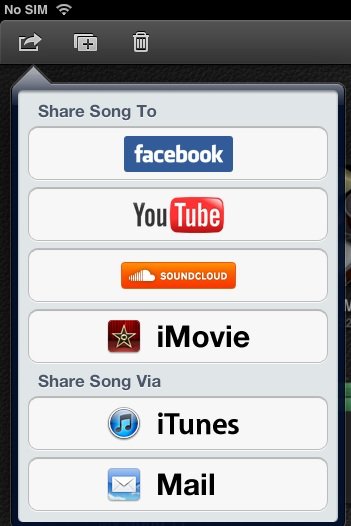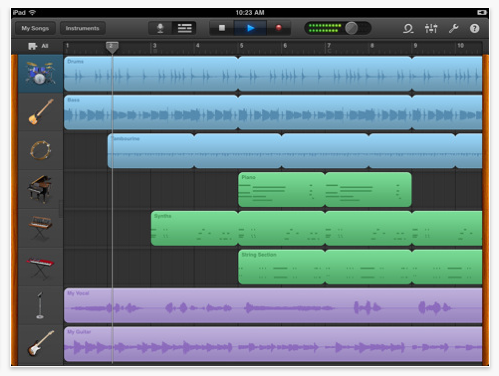Garageband Ipad Midi Files
Convert own Garageband drum track to midi file. DONE (According to instructions on this page) 3. Modify drum midi file in some other application to make it sound more like human has played it. Import modified and hopefully more natural sounding drum midi file back to Garageband. How steps 3-4 could be possible in Garageband? You can only import GarageBand Project Files (Song FIles) and Audio Files via iTunes File Sharing into GarageBand on the iPad. Importing MIDI Files is not possible. However, if you really need that feature, there is a workaround. Very complicated, but doable. Import the MIDI file into GarageBand 11 on the Mac (sorry, Mac only). However, you could consider buying Apple's Logic Pro X, which is the 'pro version' of GarageBand. It is quite pricey and might be overkill if you are just dealing with simple MIDI projects but it offers a great deal of features. With Logic you can open your Garageband projects and export your tracks as MIDI files. Apr 20, 2017 I want to export a midi track from garage band into a MIDI file. I've created a track using garageband. I have tried everything but buying logic pro, and honestly I think it is a bit waste of money if I'm only going to use it once to export a file into a readable midi format. I've tried several forums for help, but nobody have wanted to help me yet.

Make music with Touch Instruments
May 25, 2011 GarageBand for iPad Tutorial: Setting Up & Recording MIDI Keyboards With GarageBand for iPad we get some great keyboard sounds with nifty screen controls! Audiobus: Use your music apps together. What is Audiobus? — Audiobus is an award-winning music app for iPhone and iPad which lets you use your other music apps together. Chain effects on your favourite synth, run the output of apps or Audio Units into an app like GarageBand or Loopy, or select a different audio interface output for each app. Route MIDI between apps — drive a synth from a. How to import MIDI files in GarageBand iOS (iPad, iPhone) Close. How to import MIDI files in GarageBand iOS.
Use Touch Instruments to play keyboards, drums, guitars, strings, and more. Record your own vocals or plug in your guitar or bass, and play through a great selection of amps and stompbox effects.
Build your song
Choose from hundreds of Apple Loops to add to your song, add a drummer that plays along to the music you recorded, and mix your song with effect plug-ins.
Create music like a DJ
Use Live Loops to create electronic music by simply tapping cells and columns in the grid to trigger musical loops. You can build your own arrangements, then improvise and record a Live Loops performance.
Download free loops and instruments
Use the Sound Library to download and manage sound packs containing hundreds of loops, sounds, Touch Instruments, drum kits, and more. GarageBand lets you know when new sound packs are available to download.
To browse the GarageBand User Guide for iPad, click Table of Contents at the top of the page.
Here in North America the NHL playoffs are now in full swing and perhaps you’re inspired to play some rocking organ! With GarageBand for iPad we get some great keyboard sounds with nifty screen controls! Not only can we use these keys in our songs that we’re recording, but as I explained in a recent tutorial, live use is also a possibility!
Setup and Equipment Needed
There are a few things we need.

- Controller Keyboard with power supply - There are many to choose from and I use an Axiom Pro 61. You will definitely need the power supply as the iPad does not provide power through it’s dock port. If you want to use the Korg Nano series, you will need a USB hub with power supply.
- Camera Connection Kit - Our keyboard controller communicates with GB through this device.
Axiom Pro 61
Apple's Camera Connection Kit
Controls
Each instrument has it’s own layout (organ with drawbars, synths with filter controls) but also there are some functions just above the keyboard and these will vary with the instrument selected. For example, “Sustain” will be on piano but not organ, organ will have the “Rotary” switch for the Leslie, all depending on the instrument.
Although we’re going to be using a keyboard controller, if you want to use the onscreen keyboard, you get different controls for how your screen keyboard responds. On the far left is an “Octave” plus and minus. A middle button for “Glissando”, “Scroll”, “Pitch” which vary again depending on the instrument selected and the right side has a “Scale”, “Arpeggiator” and “Keyboard Layout”.
“Glissando” lets you slide across the keys like a real keyboard would. Think of the piano player using the back of his hand and sliding up or down the keys.
“Scroll” allows you to play a note and while holding it, slide the keyboard up or down. Useful if you need to get into different octaves of the on screen keyboard quickly.
“Pitch” is a like a pitch bend wheel but lets you pitch up or down between notes simply by sliding your finger. Great for the vintage synths!
“Scale” is great for solos if you want to try different sounding scales in a piece of music. Once you pick the scale you want to use, the keyboard becomes more like a single row marimba minus the #/b keys. If you use a kb controller, you will still have all the notes available but you can learn what notes are used by playing them on the iPad and matching them on your keyboard. You’ll soon be playing “Klezmer” with ease!
“Arpeggiator” is your freedom to play multiple notes with one chord held down. You can choose note order, rate, and octave range. Great for dance tunes or your version of “Teenage Wasteland”! Unfortunately, the arpeggiator does not work with a KB Controller.